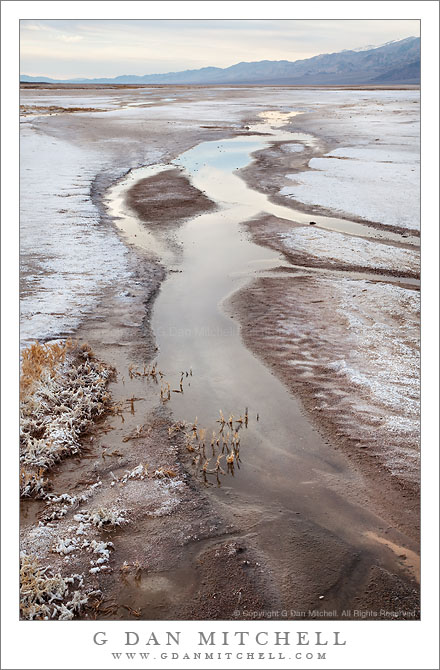
This is another image from my productive half hour or so on the edge of the Death Valley salt flats near a salt spring on a cloudy February morning. These shallow pools obviously have the potential to reflect light and shape from the clouds and the surrounding terrain, and their narrow winding channels provide a relief to the otherwise relatively uniform terrain of the flats.
This photograph includes just a bit of the plant (which I believe is a type of saltgrass) that grows in the hostile and alien terrain at the source of the salt spring on the edge of this sun-blasted salt flat. Aside from places like Antarctica or the very highest alpine peaks, I’m hard pressed to think of other places that are less conducive to life. Yet, even here some small creatures are found in the water and these grasses somehow manage to survive. (And a short distance up the wash above the salt flat, new plants were beginning to sprout among the stones.) The grasses not only grow in very salty water, but many of them – including some at the lower left in this image – are encrusted in the dry salt.
Dealing with the extremely large difference in distance between the foreground mud, water, and plants at my feet and the distant mountain range and sky was tricky. The fact that a relatively long 50mm focal length was required for the composition I saw made it even more difficult – a shorter focal length would have given me much more depth of field. This would have been the perfect place to use a tilt/shift lens… but I don’t have one! Instead I resorted to a technique that can work very effectively when you shoot digitally, namely “focus bracketing.” Once I composed the shot I made three exposures, with each focused at a different distance from the camera. In the end it turned out that two covered it pretty well, with one focused on the mud/water/plants at my feet and the other focused on a much more distant point. In the post-processing stage in Photoshop I carefully aligned the two images (necessary since they shift with the different focus settings) and then used a mask to blend the sharpest portions of the two shots.
The jury is still out on whether this is better than using tilt/shift lenses or just a different alternative. With a tilt/shift I could have captured the scene in a single exposure that would have been sharp throughout the frame, making the post-processing technique unnecessary. However, in addition to having to carry another expensive prime lens I would have had to spend considerably more time setting up the shot… and the conditions out here were not exactly static!
G Dan Mitchell is a California photographer and visual opportunist. His book, “California’s Fall Color: A Photographer’s Guide to Autumn in the Sierra” (Heyday Books) is available directly from him.
G Dan Mitchell: Blog | Bluesky | Mastodon | Substack Notes | Flickr | Email
All media © Copyright G Dan Mitchell and others as indicated. Any use requires advance permission from G Dan Mitchell.
Discover more from G Dan Mitchell Photography
Subscribe to get the latest posts sent to your email.
